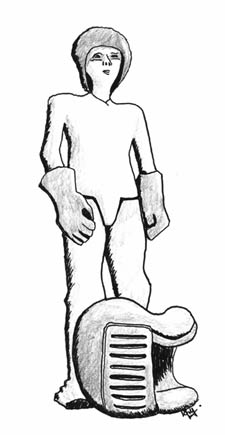

Home - Lagos - Other Places - Map
A Visit to the Algarve in 1572
BY WENDY NAZAR
| Just after
the Christmas of 1572, the 18 year-old Boy King, Dom Sebastião, paid a visit to Lagos.
Dom Duarte, High Constable of the Kingdom, and a group of important nobles accompanied
him. The king’s first concerns were to inspect the fortress at Sagres and the
Franciscan monastery at Cape S. Vicente. On January 1st the party left Lagos, but split up at Raposeira, as it was known that the monastery was small and would be unable to cater for such a large crowd. The king went on with a modest group, which had to include his musicians, and reached the monastery at vespers to be greeted by the friars. As it was the Eve of St. Vincent’s the place was absolutely packed with pilgrims. Despite the removal of the saint’s remains to Lisbon, the place was still greatly venerated where his body had rested. The pilgrims had flocked in from all the local villages and as far afield as Lagos. The king made a short tour of the monastery and then travelled back to the fortress at Sagres, where he was greeted by a fusillade of all the available artillery. He returned to the Cape to spend the night with the Franciscans, despite the crush. Meanwhile, Dom Duarte, in charge of the Raposeira party, left the high road and went down to the track along the coast to inspect all the anchorages and the tuna net stations (Armações). On their way to Sagres Fort they briefly stopped at the Baleeira fortress, a minor post that they found poorly equipped with a few artillery pieces. This had been reckoned sufficient to protect the tuna fleet that often sheltered in the bay They reached the main Fort that night, arriving by torchlight. The garrison of sixteen soldiers greeted Duarte’s party with a barrage of all the cannon again and the firing off of their hackbuts, even though it was probably past their bedtime. During the royal visit the company were shown some documents and souvenirs of the Infante Dom Henrique, which caused quite a stir. Even in those days his fame and renown aroused a great curiosity On the Thursday a further inspection of the fort was made and the decision taken to provide more artillery. The church there was very poor, too, especially as no one had died in the area recently. The shortage of deaths meant that there was no income coming from the masses and services for the souls of the departed. Dom Duarte attended the morning communion there, whereas the young king heard mass at Cape S. Vicente. They all met up at the fort again, where the Sagres town councillors kissed the king’s hand in greeting and yet another arquebuscade thundered out, startling the sea gulls. Though the cannon were few in number, there must have been plenty of gunpowder, for the artillery was fired once again as the king made a further tour of inspection. Returning to the Monastery the next morning, Dom Sebastião ordered a halt near a small cave, where he listened to his musicians. He had insisted that they be in his group; like any teenager he took his "Walkman" with him. After the king’s departure for St. Vincent’s, Dom Duarte went hunting for hares. That took up the morning. In the afternoon he indulged in fishing, local style, from the cliffs and finished the day getting in some target practice. The young king arrived back at Sagres with just enough daylight to spare for him to inspect the newly dug foundations for the proposed bastions. On the Friday, Dom Duarte and his party joined the king at Cape S. Vicente for another spot of fishing, before they all returned together to Lagos. Later in the same year, Dom Sebastião issued a new charter for Lagos, elevating the town to the status of a city. Soon it became the capital of the Kingdom of the Algarve, and the governor took up residence in the fortifications opposite the town hall. Just over three years later the troops mustered between the Paços do Concelho and the governor’s palace. There their king addressed them from one of the windows, before they left on the ill-fated expedition to Morocco. At Alcaçer-Quibir many were to die, including Dom Sebastião, himself, leaving no direct heir to the throne. His body was believed to have been brought back and buried in the Jeronimos Monastery.Though he died young, and probably needlessly, this sovereign became "the king who would return", as on the death of his uncle, the cardinal king Henrique, Portugal became little more than an annex of Spain, and a national hero was needed to maintain the Portuguese identity. |
 El-rei Sebastião The Cuteleiro statue of the boy King Sebastian
The window in the Governor's Palace, Lagos |